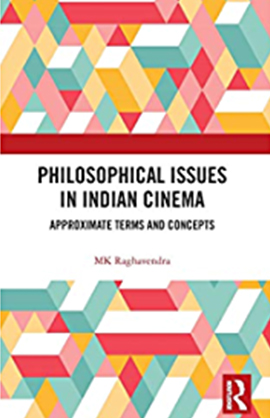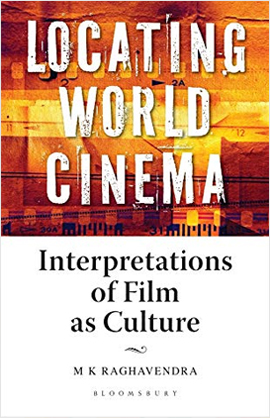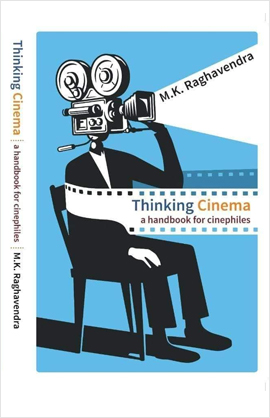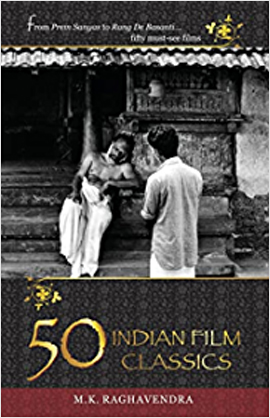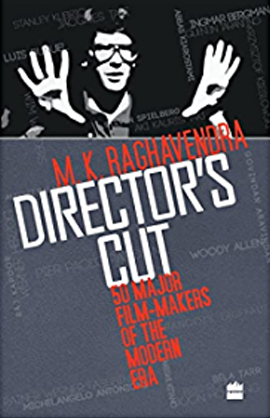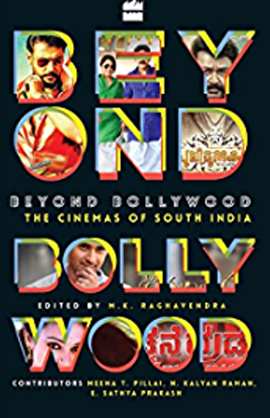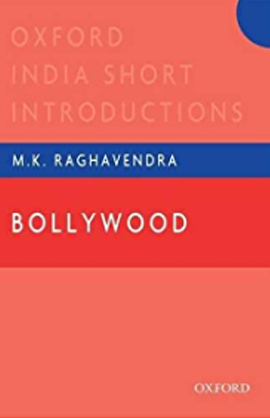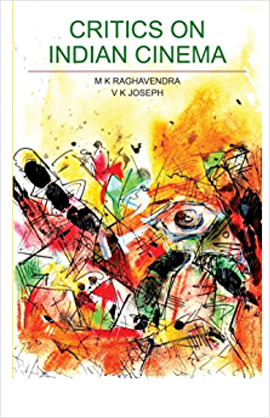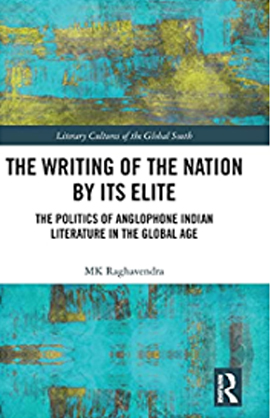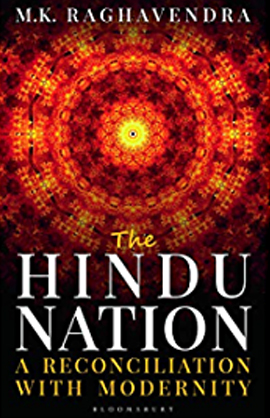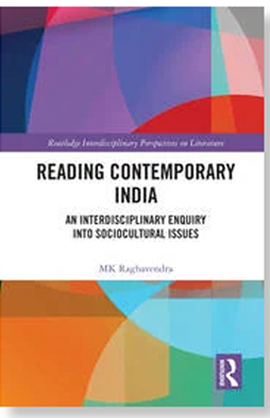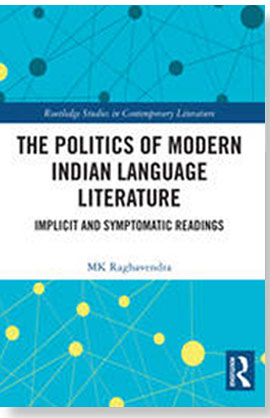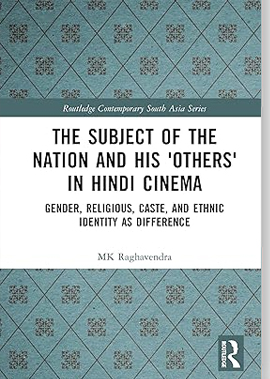Books by MK Raghavendra
Seduced by the Familiar
Narration and Meaning in Indian Popular Cinema (Oxford University Press, 2008)Bipolar Identity
Region, Nation, and the Kannada Language Film (Oxford University Press, 2011)The Politics of Hindi Cinema in The New Millennium
Bollywood and the Anglophone Indian Nation (Oxford University Press, 2014)Philosophical Issues in Indian Cinema
Approximate Terms and Concepts (Routledge, 2021)Locating World Cinema
Interpretations of Film as Culture (Bloomsbury, 2020)Thinking Cinema
A Handbook for Cinephiles (FIPRESCI-India, 2022)50 Indian Film Classics
(HarperCollins, 2009)Director’s Cut: 50 Major Film-Makers of the Modern Era
(HarperCollins, 2013)Beyond Bollywood: The Cinemas of South India
(HarperCollins, 2017)Bollywood
(Oxford India Short Introductions, 2016)Critics on Indian Cinema (editors MK Raghavendra, VK Joseph)
(FIPRESCI-India, 2021)The Writing of the Nation by Its Elite
The Politics of Anglophone Indian Literature in the Global Age (Routledge, 2021)The Hindu Nation
A Reconciliation with Modernity (Bloomsbury, 2021)Reading Contemporary India
An Interdisciplinary Enquiry into Sociocultural Issues (Routledge, 2025)The Politics of Modern Indian Language Literature
Implicit and Symptomatic Readings (Routledge, 2024)Without Empathy
Irony and the Satirical Impulse in Eight Major Filmmakers (Routledge, 2025)The Subject of the Nation and His 'others' in Hindi Cinema: Gender, Religious, Caste, and Ethnic Identity As Difference
Hardcover – 17 September 2025Seduced by the Familiar
Narration and Meaning in Indian Popular Cinema (Oxford University Press, 2008)
Description
Hindi popular cinema has played a key role as a national cinema because it assisted in the imagining of a unified India by addressing a public across the nation-to-be even before 1947. After an introduction that functions as a survey of theorizing about Indian by scholars hitherto, the book has an initial chapter exploring the strategies by which popular cinema produces meaning for its audiences. Examining the diverse elements that constitute the "popular" in Indian cinema, M.K. Raghavendra undertakes, in this book, a chronological study of films to speculate on narrative conventions, thematic continuities, myths, archetypes, and other formal structures that inform it from its hesitant beginnings up to the 1990s. A significant contribution to film studies, the book makes crucial connections between film motifs and other aspects of culture, exploring the development of film narrative using the social history of India as a continuing frame of reference.“Sometimes, the simplest things are the most difficult to do.…What could be easier than studying the progress of a nation through the stories told by its most popular cinema? Well, the surprise is that few books have set themselves such an ambitious task and fewer have succeeded. So, if you haven't already been underwhelmed by the multitude of books being churned out about Bollywood, M.K. Raghavendra's work, clearly the result of several years and not borne of the overnight desire to cash in on a growing global fad, is just perfect for anyone who loves Hindi cinema and wants more than a handful of glossy pictures and reams of glassy-eyed prose.”Kaveree Bamzai, ‘A Lifelong Affair’, India Today, Sep 22, 2008
Bipolar Identity
Region, Nation, and the Kannada Language Film (Oxford University Press, 2011)
Description
The first comprehensive inquiry hitherto into the origin and growth of a regional language cinema in India in socio-political terms, this book traces the development of Kannada cinema from the 1940s to the new millennium. Focusing on the role regional language cinema plays, the book examines the conflict between the 'region' and the 'nation' in the regional consciousness. Raghavendra traces the shape of Kannada cinema to its origins in a princely state under indirect British rule and enquires into the effect of the linguistic reorganization of the states in the 1950s upon the regional identity. Exploring the influence of national developments—from the ascendancy of Indira Gandhi in the 1960s to economic liberalization in the 1990s—on regional identity, the book provides first-time assessments of the Kannada star Rajkumar as a regional icon and the changing meaning of Bangalore city to the Kannada-speaking public.“But there is also the beginning of the most importantaspect of Rajkumar noted by cultural critics, which is the building of an ‘ethical hero’—in contrast to the Tamil ideological hero in M.G. Ramachandranand the Telugu religious hero in N.T. Rama Rao.…The ideological hero therefore came out of a politically polarized milieu in which mass mobilization had taken place and adversaries identified…. N.T. Rama Rao as a ‘religious hero,’… appeared in a milieu in which (because Hyderabad was under the Muslim rule of the Nizam) religious identity was determining. The common man’s Telugu was perhaps also placed in opposition to the elitist Urdu, which is why this manifested itself as language nationalism…I would like to argue here that the ‘ethical hero’ represented by Rajkumar came out of a milieu in which there was little political polarization. Rajkumar in the later films of the 1960s is the voice of the ‘good’ and his adversaries arenot identifiable as traders, landowners, the upper-castes, or servants of the state, etc. (which are all political categories), but simply as ‘bad people’ who do things that are not legally and ethically correct. ‘Incorrect’ is initially going against dharma but it also takes other shapes gradually—like promoting superstition as in BangaradaHoovu or forging currency as in Jedara Bale….This has a parallel in the pronouncements of the first Congress government in Greater Mysore. If the first Congress raj promised that it would be a ‘panaceafor all public ills’, Rajkumar’s films exhort against the same ills withoutidentifying them politically.” (pp. 33-38)
The Politics of Hindi Cinema in The New Millennium
Bollywood and the Anglophone Indian Nation (Oxford University Press, 2014)
Description
Popular Hindi cinema metamorphosed unrecognizably in the new millennium. An expanding urban middle-class viewer base, ever growing in its Anglophone cultural absorption, fuelled the multiplex boom at home. A slew of popular movies in tune with the sensitivities of the diasporic Indians came to define ‘Bollywood’ as a powerful global brand and a lifestyle banner. Another kind of mainstream cinema emerged in opposition to the dominant ‘elitist’ presence, a cinema meant less for multiplexes but still not ‘traditional’ in the old way. The Hindi film industry itself changed radically post 1990s, and so did the meanings, mores, and ideologies that were embedded in Hindi cinema. Going beyond the conventional theory-laden mode of analysing the political moorings of mainstream cinema, M.K. Raghavendra accords primacy to their ‘text’, treating them as rich reflections of the goings on in contemporary society. Taking cinema and cinema-viewing as a conjoined site of enquiry, he brings together a revealing and enlightening analysis of 28 Hindi blockbusters from the 2000s. With a close reading of films such as Rang De Basanti, Veer-Zaara, Bunty Aur Babli, 3 Idiots, Dabangg, Rajneeti, and Zindagi Na Milegi Dobara, Raghavendra untangles the threads of myriad new imaginaries of contemporary India and Indian-ness, embedded in a transformed Bollywood.“The primary method of (Bhandarkar’s Page 3), evidently, is to deal with, simultaneously, two sides of society: the privileged with their lavish lifestyles and the hidden underbelly. This book is devoted primarily to the asymmetric nation and Page 3 is about a similar asymmetry—one that is found in contemporary journalism. But the film itself appears ‘asymmetric’ and the principal reason is that it make sthose without privilege live outside the periphery, as it were. There is certainly no effort on the part of the film to present the privileged as a self-contained 'community’ and a principal charge against them is that they are self-obsessed, and indifferent to the rest of the Nation. Still, when drivers and security men—who will have pressing concerns of their own—are preoccupied with their masters. The purpose may be social commentary but it also suggests that the less privileged live only vicariously.” p 102.
Philosophical Issues in Indian Cinema
Approximate Terms and Concepts (Routledge, 2021)
Description
This book interrogates the vocabulary used in theorizing about Indian cinema to reach into the deeper cultural meanings of philosophies and traditions from which it derives its influences. It re-examines terms and concepts used in film criticism and contextualizes them within the aesthetics, poetics and politics of Indian cinema.The book looks at terms and concepts borrowed from the scholarship on American and world cinema and explores their use and relevance in describing the characteristics and evolution of cinema in India. It highlights how realism, romance and melodrama in the context of India appear in a culturally singular way and how the aggregation of constituent elements – like songs, action, comedy – in Indian film can be traced to classical theatre and other diverse religious and philosophical influences. These influences have characterized popular film and drama in India which present all aspects of life for a diverse nation. The author explores concepts like ‘fantasy’, ‘family’ and ‘patriotism’ by using various examples from films in India and outside, as well as practices in the other arts. He identifies the fundamental logic behind the choices made by film-makers in India and discusses concepts which allow for a fresh theorizing on Indian cinema’s characteristics.
“The word ‘philosophy’ has a forbidding sound to the lay public, but this book has no exalted ideas to offer about life or reality through cinema. It does not look at Indian film through the prism of Indian philosophical systems. It does not attempt to deal with the philosophies of film in general butconcerns itself specifically with Indian film. But it refers to the proposition (by Ludwig Wittgenstein) that philosophy is an activity focused on removing misunderstandings in the use of language and pertains to the ‘foreign’ meanings of terms commonly used in the study of Indian cinema. Indian cinema is made in Indian languages and relies on a view of the world which was not given expression to in English; still, English is the only language in which theorizing about Indian cinema takes place. This implies that whatever terms or concepts are employed in describing Indian film – for instance ‘realism’ and ‘melodrama’ – are essentially approximations or misuses because the terms arose in non-Indian contexts. They need to be reconciled with Indian cinema by qualifying them – that is, what ‘melodrama’ means in Western studies like that of Peter Brooks – and the meanings they have for Indian cinema need to be compared. This will evidently not lead to an ‘Indian’ understanding of Indian film but a revision/correction of the way it has been understood in film studies or criticism.” P 1.
Locating World Cinema
Interpretations of Film as Culture (Bloomsbury, 2020)
Description
Locating World Cinema argues for the importance of understanding the local context of a film's creation and the nuances that it conveys to the spectator. It examines the socio-cultural contexts intrinsic to cinema from milieus like the USSR/Russia, China, Japan, France, the US, Iran and India. The book analyses the works of some of the more celebrated but, at times, less than fully understood auteurs, such as Kenji Mizoguchi from Japan; Robert Bresson, Jacques Rivette and Éric Rohmer from France; Abbas Kiarostami from Iran; Martin Scorsese from the US; Zhang Yimou from China and Aleksei German from Russia..Further, it examines how the conditions of exhibition for art house cinema has transformed into the 'global art film' that attempts to bypass the local by addressing international audiences."The writing style is lucid, the ideas expressed in the book are complex and demand attention, but the engaging descriptions of films will interest even those who have not seen them. The chapters are long and deal with a large number of concepts: textual analysis in the case of individual directors and histories of their particular cultures. There is always a coda at the end of every chapter that succinctly sums up the key points. This book, which constantly makes connections between cinema and literature as well as various other cultural signposts should prove to be an invaluable addition to the literature on world cinema for film students and general readers alike.” Devapriya Sanyal, Book Review, Film Criticism, Issue: Volume 45, Issue 1, 2021.
Table of Contents
Introduction: Between Meaning and Significance1. The Engineered Look: The Film Festival Circuit and the Aesthetics of the Global Art Film
2. A Fallible Tradition: Kenji Mizoguchi and the Post-War Transformation of Japan
3. World and Text: Interpreting Jacques Rivette
4. Unattainable Women: Sexual Anxiety and Location- Scorsese, Rohmer and Kiarostami
5. Beyond Religion: The Spiritual Cinema of Robert Bresson
6. Nation and Transgression: Ideology and the Horror Film in India and Pakistan
7. A Trajectory of Form: The Development of Soviet/Russian Cinema (1910–2010)
8. History as Polyphony: Understanding Aleksei German
9. Utopia and the Patriarchal Order: Zhang Yimou as a Chinese National Artist
Bibliography
Film Index
Index
About the Author
Thinking Cinema
A Handbook for Cinephiles (FIPRESCI-India, 2022)
Description
Ever since the DVD revolution transformed film viewing habits, even the most esoteric films are accessible to a wide public. Film Studies has also become an accepted discipline in most universities. These factors have transformed the way film and video are approached by cinephiles, but untoward is the gap between viewing cinema for pleasure and ‘studying’ it, and the two often seem at odds.After an introduction examining it, the book attempts to bridge the above gap by providing intellectual contexts to what gives the viewer pleasure in cinema. The subjects covered include the capture of the real and expression, film grammar, national cinemas, auteurs and film genres, characterization and acting, fantasy in film and the world of the melodrama. Also included are chapters on political cinema, categories of the crime film and the treatment of love and romance in film narrative. Some of the subjects are often outside Film Studies but they are essential to cinephilia. Each chapter has a separate section devoted to Indian cinema and pertaining to the aspects dealt with. The book refers to an enormous range of films that would constitute an essential viewing list. It concludes with an afterworld on film interpretation and criticism. The book is amply illustrated by plates pertaining to the films discussed.
C O N T E N T S
Introduction: Cinephilia and Film Studies 15
Chapter 1: Reality and Expression 32
Reality, illusion. Mise enscène and montage.
Subjectivity, objectivity. Realism and expression
through mise enscène. Expression through
montage. Realism, montage and mise enscène.
Character subjectivity. Subjectivity as the recall
of a familiar text. Indian Cinema: Relaying
familiar truths
Chapter 2: Film Grammar and Narration 54
The specificities of cinema. Narration in cinema:
the three systems (space, time and causality).
Other kinds of narrative logic. Indian cinema:
The strategy of the first cause
Chapter 3: National Cinemas 75
International beginnings. European alternatives
to Hollywood. The maturing of national
cinemas. American cinema. French cinema.
German cinema. Soviet/Russian cinema.
Japanese cinema. Indian cinema: constituencies
within the nation
12 | FIPRESCI INDIA
Chapter 4: Film Genres and Sub-Genres 104
The formulaic in narration. Genre as myth.
Recognizing genre films. Interpreting some film
genres (western, noir/neo-noir, musical
comedies, the horror film, the Chinese wuxia
film, 'Third world' film genres). Generic
transformation and generic purity. Indian popular
cinema and its genres
Chapter 5: Film Movements 125
Film movements and history. German
Expressionism. Soviet Montage. French
Impressionism. Italian Neorealism. The
Japanese New Wave. The French New Wave.
New German cinema. Indian films: New/
Parallel cinema of the 1970s
Chapter 6: Film Festivals and the Art Film 149
Film history and film festivals. The origin of
film festivals. The radical domination of film
festivals. The film festival circuit. The changing
shape of the art film. Indian art films at
international film festivals.
Chapter 7: Film Auteurs 166
The Auteur Theory and the auteur. The
signature characteristics of some popular
auteurs (Alfred Hitchcock, Stanley Kubrick,
David Lynch, Jean Renoir, Robert Bresson,
Ingmar Bergman, Aki Kaurismaki, Pedro
Almodovar. Federico Fellini. Michelangelo
Antonioni. Andrei Tarkovsky, Akira Kurosawa,
Bong Joon-ho, Abbas Kiarostami). Auteurism
in Indian cinema.
Chapter 8: Characterization and the Actor 210
Character as intentional action. Characterization
and Hollywood. Other kinds of characterization/
acting (French cinema, non-acting, physiognomy
and character, working with troupes of actors).
Identification and distance. Acting and
impersonation. Indian cinema: ‘Being’ instead
of ‘doing’.
Chapter 9: Melodrama and Realism 229
The elements of melodrama. Teleology and
authorial intervention. Melodrama in cinema and
its transformation (Douglas Sirk, Todd Haynes,
RW Fassbinder and Pedro Almodovar).
Melodrama and Asian cinema. Indian film
Melodrama
Chapter 10: Fantasy and its Affiliates 246
The meanings of fantastic fiction (‘Fantasy’,
‘uncanny’ and ‘marvelous’). Fantasy in film
(Science fiction, horror and disaster fantasy,
Surrealist films, alternate history, superhero
films, children's films). Fantasy in Indian
cinema.
Chapter 11: Politics in Cinema 271
Defining 'politics' in cinema. Political films as
rhetoric (Propaganda, political persuasion).
Political films as exploration (The practice of
politics, political history, the political effects of
social turmoil, interpersonal politics, political
satire, political intrigue). Political education.
Political cinema in India.
14 | FIPRESCI INDIA
Chapter 12: The Crime Film 294
Crime narratives and their popularity. The
whodunnit. The hard-boiled detective story. The
police procedural. Noir thrillers. Heist films.
Films about criminal behavior and motivation.
The crime film as art cinema. Suspense films.
Crime films in Indian cinema.
Chapter 13: Love and Romance 317
Romantic love and distance. Obstructions to
love as motifs. Love against dictate. Love and
group conflict. Extra-marital love. Love
triangles. Dark love. LGBTQ love. Vocation
and ambition as obstacles. History as
obstruction. Unrequited love. Inner obstacles.
The portrayal of love in Indian cinema.
Afterword: Film criticism and interpretation 345
Bibliography 360
General Index 369
Film Index 378
About the author 388
50 Indian Film Classics
(HarperCollins, 2009)
Description
With more than a thousand films produced annually in over fifteen languages India is acknowledged as the largest producer of motion pictures in the world. 50 Indian Film Classics provides detailed critical accounts of the most important Indian films beginning with Prem Sanyas (1925) to Rang De Basanti (2006) in languages ranging from Bengali and Hindi to Manipuri and Malayalam and representing a whole gamut of themes: from the 1930s mythological Sant Tukaram to the politically radical Calcutta ’71, from art-house favourites like Uski Roti and Mukhamukham to blockbusters like Sholay and Lagaan. These perceptive essays introduce the reader to the many moods that inform Indian cinema, the austerity of Pather Panchali, the lavishness of Hum Aapke Hain Koun…!, the solemnity of Samskara and the fun and frolic of Amar Akbar Anthony. Illustrated with rare posters and stills this is an invaluable guide to the most significant cinema India has ever produced.“He writes with equal intelligence and open-mindedness about such varied works as the 1930s Marathi film Sant Tukaram, the Manmohan Desai potboiler Amar Akbar Anthony, and Adoor Gopalakrishnan’s Mukhamukham.” Jai Arjan Singh, ‘Must Read books,’ Tender Leaves Blog.
“(His piece on Pather Panchali) is dew fresh yet has the density of a tropical forest. Similarly, the essay on K. Viswanath’s Shankarabharnam is well formulated, enlightening, and enriching. His clear-cut demarcation of popular and classical music is… a nice foray in the piece.” Ziya Us Salaam, “Delightful Review of Film Classics,” The Hindu, Feb 16th 2010.
Director’s Cut: 50 Major Film-Makers of the Modern Era
(HarperCollins, 2013)
Description
A critical introduction to the best of international film-makers in the last 50 years. This is an acutely perceptive collection of essays defining the work of fifty film-makers of the modern era. The shape of cinema is today unrecognizable from that in the 1950s but film criticism has perhaps not kept pace with changes after 1960, when cinema became modern. The collection addresses this deficit by examining the most important directors since 1960. It includes the film-makers of the French New Wave and New German Cinema, extends its attention to earlier 'modernists' like Luis Bunuel and Robert Bresson and speculates on the significance of masters like Andrei Tarkovsky and popular film-makers like Steven Spielberg. It also encompasses a whole range of more recent cinema from Abbas Kiarostami to Bela Tarr. As befits the enormous variety in the range of cinema covered, each of the essays is strikingly different in its emphasis although they are all lucidly and engagingly written. Also included are definitive assessments of five key Indian film directors -Satyajit Ray, Ritwik Ghatak, Adoor Gopalakrishnan, G. Aravindan and Raj Kapoor.“Apart from the sense of people living makeshift lives almost permanently Ghatak opens out the frame of his story (in Meghe Dhaka Tara) to admit detail that suggests a larger world not contained by the story. One motif is the train that features in several segments – including one or two in which Shankar practices music. If one were to compare Ghatak’s train with Ray’s in Pather Panchali, one could say that where Ray’s is an emblem of the ‘new’, Ghatak’s train is something that people have actually travelled in, perhaps from the homes they abandoned forever. Another device of Ghatak’s is to have musical numbers in spaces open to the elements. Shankar and Neeta sing a duet in the film – a Tagore song – as if to recall a happier time or to wish for the way things might have been, sung under a thatched roof in a settlement. Tagore’s songs are among the most cherished elements of Bengal’s heritage and the sad irony that it should be sung under makeshift circumstances makes the sequence profoundly moving. In Subarnarekha (1962) Ghatak goes a step further and has the heroine rendering a song in an actual historical space – a dilapidated World War II airfield.” (On Ritwik Ghatak)
“There are film directors I have known about, for years, mainly because of the blockbuster movies they have directed. Then, there are directors I have heard of in the passing but whose films I have never explored.There also exist films that I have seen but possibly cannot recall who directed them. And lastly, directors whose names or filmographies are entirely alien to me.Director’s Cut covers each of the above scenarios making for a brilliant, informative, and entertaining read….50 directors, 50 essays on those very souls who have made modern cinema a marvel; Director’s Cut is a beautiful addition to any film fan’s library. It is a necessity for anyone who has even the remotest interest in cinema but essential for the one who has yet to discover the magic of World Cinema.” Raghav Modi, The Sunday Book club, 10th August, 2022.
Beyond Bollywood: The Cinemas of South India
(HarperCollins, 2017)
Description
This is an anthology edited by MK Raghavendra examining four cinemas of South India – Telugu (by E Sathya Prakash), Tamil (by N Kalyan Raman), Malayalam (by Meena Pillai) and Kannada (by MK Raghavendra). While ‘Indian popular cinema’, as if by default, has come to mean Bollywood, there are other cinemas in India which are at least as rewarding to study, the largest and perhaps most intriguing among them coming from South India. Tamil, Malayalam, Telugu and Kannada cinemas have their own colourful histories, megastars and political trajectories. This anthology is an attempt to do justice to the bewildering variety there is in the body as a whole and addresses this diversity in the only way deemed possible, which is to open out the study to different approaches, at the same time to get a comprehensive look at South Indian cinema as never before undertaken.“Beyond Bollywood comprises four essays discussing the major south Indian cinemas. N Kalyan Raman, a Chennai-based writer and translator, reflects on Tamil cinema; Raghavendra, a film critic and scholar, analyses Kannada cinema; Elavarthi Sathya Prakash, author and faculty at the University of Hyderabad, examines Telugu cinema; and, Meena T Pillai, a writer and faculty at the University of Kerala, looks at Malayalam cinema…. The introduction spells out the book’s importance, and sets the tone for the essays. It clearly establishes Beyond Bollywood as a serious, academically-researched work — and not the coffee-table variety that doles out daily collection report (DCR) figures or tawdry industry gossip….BeyondBollywood is a treasure trove of information that makes it a good read — rather a must read — if you’re a cinephile.” Viju Cherian, The Hindustan Times, 12Oct, 2017.
Bollywood
(Oxford India Short Introductions, 2016)
Description
Awaara, Sholay, Deewar, Hum Apke Hain Koun..!, 3 Idiots. The success stories of these cult films are not only well known, but have also benchmarked a specific kind of cinema that exerts a far-reaching appeal. Often misunderstood to represent all Hindi cinema, Bollywood, as a distinct industry operating within Indian cinema, has not received due attention. Replete with its own set of motifs, plot devices, tropes, and even themes, much of what is produced shares not only a devoted audience, but also big budgets, stars, larger-than-life sets, and enormous revenues. In Bollywood, M.K. Raghavendra maps the dramatic journey of this popular, mainstream phenomenon. He dwells on the various departures from Western cinema and examines the characteristic traits specific to Bollywood, relating them to classical aesthetics, poetics, and dramaturgy. While also touching upon its various production and distribution practices, this short introduction explains the assorted roles it has played in suturing pan-Indian and national cinema before and after 1947, and anticipates its future as a sustained form of global entertainment.“While the domestic melodrama or social is only one category in the thirties and early forties – the mythological is another – the social begins to dominate Hindi cinema after 1947. Post-Independence melodrama may be understood as a continuation of the socials of the earlier period but there are nonetheless crucial differences. Critics have noted that Independence acquires figurability in many films after 1947 and the chief reason is the arrival of ‘loyalty’ towards an individual or a community as a strong motif, as in Anmol Ghadi. Where people were ‘good’ and ‘bad’ earlier, we have a new entity transcending this polarity because the male protagonist of Mehboob’s film is ‘good’ but nonetheless neglects the mother who did much for him. It is this loyalty towards the independent nation that translates into ‘oedipal conflict’ – as in Raj Kapoor’s Awaara (1951) since the Freudian motif is not in evidence before the independent nation enters the narrative. This loyalty which is tested can also be towards a friend (denoted as dosti and seen later in Naya Daur, 1957). Loyalty towards the community is exhibited most famously in Mehboob’s Mother India (1956) when the mother sacrifices her rebellious son for going against the law of the community. …If loyalty is brought into focus after 1947 there is also a new admission of responsibility, through the notion of conflict – between warring classes and between different attitudes towards the poor and the marginalized. Frequently, it shows itself in the class differences between the hero and heroine becoming insurmountable as in Bawre Nain (1950) and Babul (1950). In Anokhi Ada (1948) an urbane young man who wears a rose in his button hole and loves children takes care of an orphan girl and her brother, a motif which may owe to Indians ‘orphaned’ by the death of the Father of the Nation, becoming the ‘responsibility’ of Pandit Nehru (whose sartorial habits included the rose in the buttonhole). These films are not alike but still find the means to introduce the same motifs within different generic structures. For instance, in Kamal Amrohi’s Mahal (1949), the notion of two women from different classes fighting for the same man occurs in a ghostly tale. A key presence in many of these films is Dilip Kumar, whose performances in Babul and Jogan (1950) are endowed with an existential freedom uncharacteristic of the Hindi film; it is as though the male protagonist is exercising moral choices that are not typical of film heroes – who were, and have also been, frozen as types. One could argue that independence gave Indians the abrupt sense of becoming responsible for themselves and revealed itself thus in cinema.” P 11
Critics on Indian Cinema (editors MK Raghavendra, VK Joseph)
(FIPRESCI-India, 2021)
Description
This is an anthology of essays on cinema - mostly critical writing - that tries to take a 'pluralistic' approach. The impetus forit comes from the Indian chapter of FIPRESCI (FédérationInternationale de la Presse Cinématographique), the international federation of film critics with its head office in Munich.The essays are serious and most of them can be called 'academic' but its deliberately pluralistic approach comes from th erecognition that, increasingly, film study exists in an intellectual monoculture in which the excitement to be got from cinema is losing importance.CONTENTS
Section 1 : Film directors and their work
Satyajit Ray’s years of cultural apprenticeship 13
Someswar Bhowmik
The Soundtracks in RitwikGhatak’s Films 26
Sayantan Dutta
Satyajit Ray’s Mahanagar and the Weakening
of the Patriarchal Family 40
Devapriya Sanyal
The ‘Middle’ Path of Hrishikesh Mukherjee 57
Deb Kamal Ganguly
Remembering Mrinal Sen 83
John W Hood
Section 2 : Understanding Indian Cinema
The Rhetorical Construction of Motherhood
in Indian Alternative cinema (1950s to 1980s) 91
DebjaniHaldar
Symptoms of Feminist Mystification 104
in Indian Cinema
Aparajita Pujari
Two Kinds of Realism in Indian Cinema 112
Abhishek Talukder
The Representation of Caste in Indian Cinema 127
Rita Dutta
The Role of the Actor and Star in Hindi Cinema 142
Milind Damle
The Evolving Cultural imaginary in Popular
Malayalam cinema 154
V K Joseph
The Paucity of Science Fiction in Indian Cinema 171
M K Raghavendra
Hindi Cinema: Cultural Capital and Soft Diplomacy 180
Aysha Iqbal Vishwamohan
The Portrayal of Domestic Workers in Indian Films 189
Anuradha Kunda
Marathi Cinema Meets Italian Neorealism :
Preliminary Notes on Osmotic Cinema 199
Monia Acciari
Section 3: Exploring the Cinemas of the North-East
The Fortunes of Manipuri Cinema 217
MeghachandraKongbam
Assamese Cinematic Narratives :
The Changing Landscape 240
Bharati Bharali
The Cinema of the North-East :
Resistance to Stereotyping 255
Parthajit Barua
Negotiating the ‘alien’ in Axone and Aamish 273
Tias Maity
Assamese Cinema : Will the Wave Last? 288
Manoj Barpujari
The Writing of the Nation by Its Elite
The Politics of Anglophone Indian Literature in the Global Age (Routledge, 2021)
Description
This volume examines the idea of India as it emerges in the writing of its anglophone elite, post-2000. Drawing on a variety of genres, including fiction, histories, non-fiction assessments – economic, political, and business – travel accounts, and so on, this book maps the explosion of English-language writing in India after the economic liberalization and points to the nation’s sense of its growing importance as a producer of culture. From Ramachandra Guha to William Dalrymple, from Arundhati Roy to Pankaj Mishra, from Jhumpa Lahiri to Amitav Ghosh, from Amartya Sen to Gurcharan Das, from Barkha Dutt to Tarun Tejpal, this investigation takes us from aesthetic imaginings of the nation to its fractured political fault lines, the ideological predispositions of the writers often pointing to an asymmetrically constituted India.A major intervention on how postcolonial India is written about and imagined in the anglophone world, this book will be of great interest to scholars and researchers of cultural studies, literature, history, and South Asian studies. It will also be of interest to general readers with an inclination towards India and Indian writing.
Contents
Introduction1. Politics and Literary Style: Arundhati Roy’s Essays and Interviews (2001-14)
2. The Well-Born Englishman in India: William Dalrymple’s White Mughals: Love and Betrayal in 18th Century India (2002)
3. Unfinished Renunciation: Suketu Mehta’s Maximum City (2004) and Jeet Thayil’s Narcopolis (2012)
4. The Anglophone Hierarchy: Chetan Bhagat’s Fiction and Non-Fiction (2004-14)
5. A Desirable Nation: Amartya Sen’s The Argumentative Indian: Writings on Indian Culture, History and Identity (2005)
6. Taking Sides: Pankaj Mishra and Temptations of the West: How to be Modern in India, Pakistan and beyond (2006)
7. Nation as Exposition: Ramachandra Guha’s India after Gandhi: The History of the World’s Largest Democracy (2007)
8. Past as Pastiche: Amitav Ghosh’s Sea of Poppies (2008)
9. Economics without Politics: Nandan Nilekani’s Imagining India: Ideas for the New Century (2009)
10. The Other Half: Tarun J Tejpal’s The Story of My Assassins (2009)
11. Dharma and Ideology: Gurcharan Das’s The Difficulty of Being Good: The Subtle Art of Dharma (2009) and India Grows at Night: A Liberal Case for a Strong India (2012)
12. Democracy and the Lesser Nation: Jean Drèze and Amartya Sen’s An Uncertain Glory: India and its Contradictions (2013)
13. Cultural Capital: Jhumpa Lahiri and The Lowland (2013)
14. Rarefied Spaces: Barkha Dutt’s This Unquiet Land: Stories from India’s Fault Lines (2015)
15. An Unresisting People: Shashi Tharoor’s An Era of Darkness: The British Empire in India (2016)
Afterword
The Hindu Nation
A Reconciliation with Modernity (Bloomsbury, 2021)
Description
Educated Indians are violently divided between those who are drawn to Hindu nationalism and the liberals who dub them ‘communalists.’ The book begins with an introduction examining ‘nationhood’ in India and then traces the political conflict to Nehruvian cultural policy after 1947. In today’s world, no religion can claim to be superior to any other. But in pursuing ‘modernity’ and inculcating the ‘scientific’ and ‘secular’ outlook, Nehruvian rationalism created an elite liberal class that was sceptical about the majority religion, but this was not extended to other religions because of a misunderstanding of ‘secularism’. In promoting Westernised education, the preserving of local knowledge was neglected and Hinduism lost respect among the educated elite born into it. The elite class became the intermediary with the West, which now dominates academic study of India. Further, prompted by the sceptical attitude of liberal Indians, Western academics and intellectuals accord Hinduism less respect than to other religions and treat it as ‘superstition’. Traditional Indians who revere Hinduism but are products of the same lop-sided system respond by attributing false value to India’s prehistory and its past.Hinduism is not a religion but a collection of practices associated with the space now called India. Author M.K. Raghavendra examines what being ‘Hindu’ means and asks whether its practices are reconcilable with global modernity and compatible with justice and egalitarianism. While examining the obstacles a ‘modern Hindu nation’ faces, including the fixed ways of a large public, this extensively researched book also suggests measures to make India successful as a global power and Hinduism widely respected.
“An important and deeply thoughtful engagement with key political issues in India and regarding India’s highly plural internal self-perception and contested image in the world.” Werner Menski, MA, PhD, Professor Emeritus, SOAS, University of London.
Reading Contemporary India
An Interdisciplinary Enquiry into Sociocultural Issues (Routledge, 2025)
Description
The book is the first ever attempt to examine various sociocultural aspects of contemporary India, ranging from caste and hierarchy and the religious or political conflict resulting from it to literary practice and intellectual life in the public space and making interdisciplinary associations. It does this by going back to various aspects of India’s past, stretching back several millennia to those owing to public policy after independence. Many of the issues today, such as those named above, can be traced to racial mixing through centuries, which has created a multitude of conflicts that need solutions today. The book is divided into separate chapters corresponding to the issues needing addressing, and a brief note at the conclusion of each chapter makes connections with issues dealt in other chapters. The book has an introduction tracing a significant portion of India’s past and an afterword identifying crisis areas in the present.Contents
Introduction: The past as capital and burden- Caste, power and hierarchy
- Elitism, communities and democratic politics.
- Religious/political identity and conflict
- Racial discrimination
- State authority and justice
- Poverty and income disparity
- National language, link language
- Higher education and global competitiveness
- The inward look and its effects
- Local languages and Modern Literature
- Artistic/literary practice and relevance.
- Knowledge, method and intellectual life
Afterword: Education, the crisis area
The Politics of Modern Indian Language Literature
Implicit and Symptomatic Readings (Routledge, 2024)
Description
Indian literature is produced in a wealth of languages but there is an asymmetry in the exposure the writing gets, which owes partly to the politics of translation into English. This book represents the first comprehensive political scrutiny of the concerns and attitudes of Indian language literature after 1947 to cover such a wide range, including voices from the cultural margins of the nation like Kashmiri and Manipuri, that of women alongside those of minority and marginalised communities. In examining the politics of the writing especially in relation to concerns like nationhood, caste, tradition and modernity, postcoloniality, gender issues and religious conflict, the book goes beyond the declared ideology of each writer to get at covert significations pointing to widely shared but often unacknowledged biases. The book is deeply analytical but lucid and jargon-free and, to those unfamiliar with the writers, it introduces a new keenness into Indian literary criticism to make its objects exciting.Table of Contents
Introduction: Reading modern Indian ‘bhasha’ literature; Part 1: The nation and its ethnicities; 1. Literature for Performance; 2. Constructing a Syncretic History; 3. The Meaning of life; 4. Failure and Middle-class life; 5. Essentializing the Marginalized; 6. The Private as Public; 7. The Polarization of Social Experience; Part 2: Modernity and its effects; 8. Breaking Taboos; 9. Modernity and Interiority;10 Unstable Hybrid; 11. Outward Profusion, Inner Silence; 12. Another Modernity; 13. Literary Modernism and the Community; 14. Living in the World; Part 3: Gender and the position of women; 15. Nation of Women; 16. Tradition, Privilege and Gender; 17. ‘Eternal’ Womanhood; Part 4: The experience of caste; 18. Literature and Testimony; 19. View from Under; 20. The Nostalgia of the Small Farmer; 21. Lost Authority, Soft Power; 22. The Myth of Varna; Part 5: Humanism and authorial discourse; 23. The Popular Writer and Literature; 24. Humanism without Politics; 25. A Tapestry called Humanity; Afterword: Patterns in Bhasha WritingBiography
MK Raghavendra is a cultural, literary and film critic and scholar with political discourse as the focus in his analyses. He won the National Award for Best Film critic and received a Homi Bhabha Fellowship to study narration in Indian popular cinema. He has published 11 books on cinema from international publishers and contributed essays to anthologies and journals. He has also authored a book on politics The Hindu Nation: A Reconciliation with Modernity and two books of literary criticism from Routledge. His writing has been translated into Polish and French and two books also into Russian.Without Empathy
Irony and the Satirical Impulse in Eight Major Filmmakers (Intellect, 2025)
Description
From apparent melodrama and eroticism to fantasy and horror, these eight directors redefine satire’s limits, providing evidence that irony in cinema often goes unrecognized.In Without Empathy, MK Raghavendra investigates how irony and satire function in cinema by focusing on the work of eight visionary directors—Luis Buñuel, R.W. Fassbinder, Stanley Kubrick, Robert Altman, Paul Verhoeven, Aki Kaurismäki, Aleksei Balabanov, and David Lynch. At a time when irony is increasingly scrutinized as a mode of expression, this book reconsiders its role in film, revealing how these auteurs deploy wit and subversion in ways that unsettle audience expectations.
Through close readings of selected works, Raghavendra identifies layers of meaning beneath the surface of films often misread. The book situates these directors within broader traditions of cinematic satire, while simultaneously interrogating what their work has to say about society, culture, and human folly. Without Empathy is a lucid read for scholars and students of film studies and communication, providing a provocative lens on how satirical intent is not always recognizable today and how its actual targets can make society uncomfortable.
Table of Contents
Introduction: Irony, Satire, and Empathy- Luis Buñuel: Unaffiliated Radicalism
- Stanley Kubrick: The Failure of Human Systems
- RW Fassbinder: The Original Sin
- Robert Altman: History, Ideology, and Generic Revision
- Paul Verhoeven: Satirical Impulse goes Clandestine
- Aki Kaurismäki: Irony and Hopelessness
- Aleksei Balabanov: Collapsed Utopia
- David Lynch: Public Mythologies and Personal Fantasies
The Subject of the Nation and His 'others' in Hindi Cinema:
Gender, Religious, Caste, and Ethnic Identity As Difference
Routledge, 2025
Description
This book analyzes the representations of the subjects of Hindi cinema as a way of gaining insights into the hegemony of the upper-caste Hindu male in narratives of nationhood.Given that Hindi cinema has narrativized the nation after 1947, the book examines how these subjects were chosen and argues that they were upper-caste, Hindu and predominantly male. The author's analysis shows asymmetries in the constitution of the ‘imagined nation’ in the public consciousness. Women, the marginalized categories, and minorities were presented as ‘others’ with separate stories for the issues dealing with them—but distinct from that of the nation. Stories centered on women primarily highlight their position within society. In this context, the book argues that it is the male protagonist whose story mirrors that of the nation as allegory.
A novel contribution to the field of Bollywood Studies, this insightful work will be of interest to those studying Hindi cinema and film studies, political science and history, as well as gender studies.
About the Author
MK Raghavendra is an independent scholar of culture, literature and politics, specializing in film, particularly its political aspects. He won the National Award for Best Film Critic in 1997 and received a Homi Bhabha Fellowship to research popular film narrative. Since then he has authored six volumes of academic film scholarship from international publishers including Routledge. Apart from these, he has authored three academic works on literature, culture and politics. He has published in national and international anthologies and journals on the above subjects, and his writing has been translated into French, Polish and Russian and published.Contents
Introduction- Film Form and Ideology
- The Trajectory of the Hero in Bollywood
- Representing Women
- The Portrayal of Muslims as Religious Minorities
- Caste Identity and Conflict
- Ethnicities and Hindi Cinema
- Representing the Social ‘Other’
- Pakistan as the National ‘Other’
Afterword: Asymmetric Nationhood



